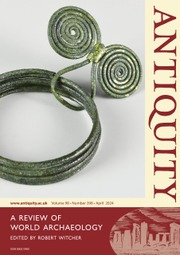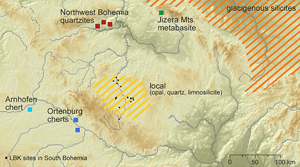Introduction
The Linearbandkeramik (LBK), from 5500–4900 BC, is a thoroughly studied archaeological culture that enjoys particular attention because it introduced agriculture and sedentism into central Europe. Spreading rapidly during the fifty-fourth century BC (Jakucs et al. Reference Jakucs2016), the LBK farmers chose to exploit the most favourable loess lowlands. These regions, therefore, offer an abundant archaeological record that has attracted numerous excavation projects and scientific examinations. However, less attention has been paid to upland and highland regions although they also contributed to the seemingly uniform LBK area. Focusing on the region of South Bohemia in Czechia, our interdisciplinary project seeks to address this bias. Excavations with an intensive sampling strategy have allowed us to apply archaeobotanical, anthracological, archaeozoological, pollen and phytolith analyses, supported by radiocarbon modelling.
Farmers on the periphery
South Bohemia is mainly an undulating or hilly landscape with altitudes of 350m and above. Even in the relatively flat central basins, fertile luvisols are limited to islands of loess loam subsoil. The most productive dark-soil types such as Chernozem are completely absent today. When LBK communities entered the region, they found a landscape mosaic that was structured differently from the neighbouring lowlands of Bohemia, Moravia, Lower Bavaria and Lower Austria. Anthracological data and palynological models indicate open-canopy forests dominated by oak and pine. Deciduous broadleaf trees (elm, linden, maple, ash) are locally recorded but their presence was generally low; spruce was relatively common, particularly close to frequent wetlands. Only between five and 10 per cent of the landscape might have been covered by grasslands (Kuneš & Abraham Reference Kuneš, Abraham, Chytrý, Danihelka, Kaplan and Pyšek2017).
Regarding its spatial distribution, the LBK occupation of South Bohemia formed an enclave distant from others. With only 17 sites recorded so far, the local settlement was clearly less intensive (Figure 1). Phytoliths sampled from an LBK pit at the site of Radčice 1 (49.16546N; 14.19059E) came from steppe grasses, which suggests that small niches of grassland vegetation might have been preferred by incoming colonists because they resembled the lowland environment. Settlements established within these microregions comprised standard LBK longhouses with flanking pits although, in most cases, only fragments of their former ground plans could be reconstructed.

Figure 1. LBK settlements in South Bohemia and neighbouring regions (maps by V. Vondrovský; data supplied by: Gruber Reference Gruber2009, Trampota Reference Trampota2015, Bayerisches Landesamt für Denkmalpflege 2019, Archaeological Map of the Czech Republic 2023).
In South Bohemia, there is no evidence of early LBK pottery. This suggests that the area was omitted from the initial wave of LBK colonisation that reached all surrounding regions. Chronological modelling based on 290 radiocarbon measurements reveals that the first farmers entered South Bohemia later than elsewhere, in 5232–5067 cal BC (95% probability) or probably in 5227–5102 cal BC (68% probability) (Figure 2).

Figure 2. Radiocarbon probability distributions for the start and end of the LBK culture in particular regions: A) their duration; B) time differences between the LBK colonisation of South Bohemia; C) and other regions. Modelled in OxCal v4.4, using the IntCal20 calibration curve (Bronk Ramsey Reference Bronk Ramsey2009; Reimer et al. Reference Reimer2020) (figure by V. Vondrovský).
It is 99.8 per cent probable that this was after the neighbouring lowlands were already colonised. The medians of time differences are indicated as 128–166 years with a minimum difference of 37 years (95% probability). At the end of the South Bohemian LBK, a steep decrease in the already low settlement density is observed as only three sites persisted to the post-LBK period.
The delayed and less-intensive LBK colonisation of South Bohemia opened a window of opportunity for local hunter-gatherers to thrive longer than elsewhere. For example, in the eastern part of South Bohemia, at least 11 hunter-gatherer campsites and significant human impact in the palaeoenvironmental record have been identified around Lake Švarcenberk. The intensive burning and clearing of littoral vegetation, and other indicators of non-farming activities, took place here in the Early Holocene and continued after the LBK farmers arrived in the region (Figure 3). While hunter-gatherers utilised this lake zone, farmers dwelled on nearby loess islands (Figure 4).

Figure 3. Age-depth model and palaeoenvironmental anthropic indicators in the central core of Lake Švarcenberk (figure by V. Vondrovský & P. Pokorný).

Figure 4. Site locations indicating proximity of LBK farmers and hunter-gatherers in South Bohemia (map by J. Bumerl).
Networks
Indigenous hunter-gatherers by the lake produced 75–90 per cent of their lithic tools from local sources. Despite the proximity, these types of materials are marginal in assemblages from LBK settlements, even though miniature flakes were acquired during excavations by wet sieving. Instead, South Bohemian farmers relied on good-quality materials imported as partly finished products over larger distances from neighbouring regions (Figure 5).

Figure 5. Lithics raw materials utilised by LBK farmers in South Bohemia (figure by P. Šída and J. Bumerl).
Polished stone tools were produced exclusively from the Jizera Mountains metabasite. For chipped tools, Ortenburg cherts, which varieties outcrop in eastern Bavaria, were utilised in considerable amounts (see Figure 5). However, this material was not passed down the line to other LBK communities in Bohemia (Burgert Reference Burgert2016). In addition, the generally high degree of reuse and exploitation of stone cores indicates that South Bohemian farmers faced a dearth of raw materials. Yet, frequent inter-regional contacts must have occurred because the decoration of South Bohemian pottery reflects the motifs of the Notenkopf and Šárka styles typical of the late LBK in Bohemia and eastern Bavaria.
Subsistence
LBK communities in South Bohemia relied largely on domesticated species; the proportions of wild sources did not exceed figures documented elsewhere in other LBK regions (Figure 6).

Figure 6. Examples of archaeobotanical remains recovered from LBK sites in South Bohemia (figure by M. Ptáková).
The archaeozoological record in South Bohemia is negatively affected by biostratinomic factors but evinces a standard LBK spectrum composed mainly of domestic ruminants and pigs, supplemented by wild mammals such as red deer and small birds. Preliminary results of the archaeobotanical analysis reveal the inclusion of barley and Timopheev's wheat (also known as ‘new’ glume wheat) into the conservative LBK repertoire of cultivated crops, which was generally dominated by einkorn and emmer (Ptáková et al. Reference Ptákováin press). Barley and Timopheev's wheat have been more sustainable in local conditions of the South Bohemian region. Cultivating a diverse selection of crops also reduced the risk of total crop failure.
Conclusion
Although entangled in inter-regional distribution networks, South Bohemia represented a distinctive settlement zone surrounded by fully inhabited lowlands. In this later-colonised inner periphery, the LBK cultural system based on farming and sedentism coexisted over a long period with indigenous groups of hunter-gatherers. However, interactions remained sparse, as minimum attributes were shared between them. Newcomers never abandoned the core principles of the LBK lifeway, although early farming practices were likely limited by the region's specific environment. They consumed mostly domesticated sources, lived in longhouses and, despite the considerable demands of transportation, relied on non-local materials to produce lithics. Their adaptation efforts towards a more diverse range of cultivated crops is, nevertheless, exceptional in the general LBK context. Our project highlights the significance of studying regional developments to gain a comprehensive understanding of early agricultural expansion in central Europe.
Funding statement
This work was supported by the Czech Science Foundation under the project ‘At the fringe of the neolithization: strategies of the first farmers of South Bohemia’ (21-16614S).









